Georgina Campbell's Book Reviews
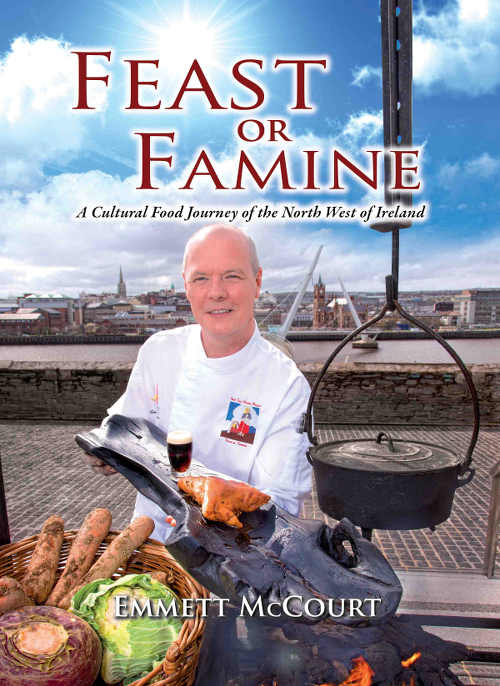 Feast or Famine: a Cultural Food Journey of the North West of Ireland by Emmett McCourt. Guildhall Press, hardback, 272 pp, fully illustrated. £19.95.
Feast or Famine: a Cultural Food Journey of the North West of Ireland by Emmett McCourt. Guildhall Press, hardback, 272 pp, fully illustrated. £19.95.
Passion is an overused word these days, but it’s hard to think of a better one when describing Derry chef Emmett McCourt and his relationship with the foods, and food heritage, of the North West of Ireland.
He may have worked in some of the world’s finest kitchens, but his roots are in this region and his love and respect for its traditional foods and cooking methods is palpable.
This book is at the centre of the multi disciplinary Irish Food Heritage Project (www.feastorfamine.ie), initiated by Emmett in 2011 “to capture and preserve the food history of the North West of Ireland” with the support of the North West Regional College, where he lectures and cooks in the college’s restaurants.
The project is proving an enormous success, with new strands developing all the time - a mobile cookery demonstration theatre and road show is a recent addition, designed to tour markets, fairs and food events around the country.
Even a quick glance through this book will give an idea of the dedication required to collect and collate such a massive amount of material about the food and culture of the North West. Every page is jam-packed with fascinating stories, songs, poems, recipes and photographs - lots of photographs.
This is not one of those design-led books with carefully curated images that are given acres of space around them, this one uses every available corner to fit in just one more brilliant producer, shopkeeper or cook (or their grandfather, or a great aunt..), the foods that they have loved down the years, and the historical context that has left its legacy - the Famine, emigration and World War Two and many others. There’s a sense of urgency in the way that it’s all packed in, as if it mustn’t be lost or go to waste - which indeed was the inspiration for the Irish Food Heritage Project in the first place.
With the (generally welcome) growth of modern Irish cooking there is a tendency, at the moment, to be dismissive about our simple traditional foods and cooking methods. Should persuasion be needed, Feast or Famine demonstrates vividly why that is a mistake.
As well as providing a fascinating introduction to the region’s food history, anyone planning a visit to the North West will find Feast or Famine a useful practical guide, as the final sections cover the contemporary scene, including a chapter detailing The City of Derry’s Unique Culinary Adventure, with a map and over fifty Food Heritage Hotspots highlighted, including many of the best pubs and restaurants.
Having already been successful at national level in the Gourmand World Cookbook Awards (www.cookbookfair.com), Feast or Famine was also shortlisted in the Best Local Book and Best Culinary Travel Book category in the ‘Gourmand Best in the World’ Competition, to be held in China this month. This book is an extraordinary achievement and deserves to do well - it is certainly a book that I will enjoy coming back to, time and time again.
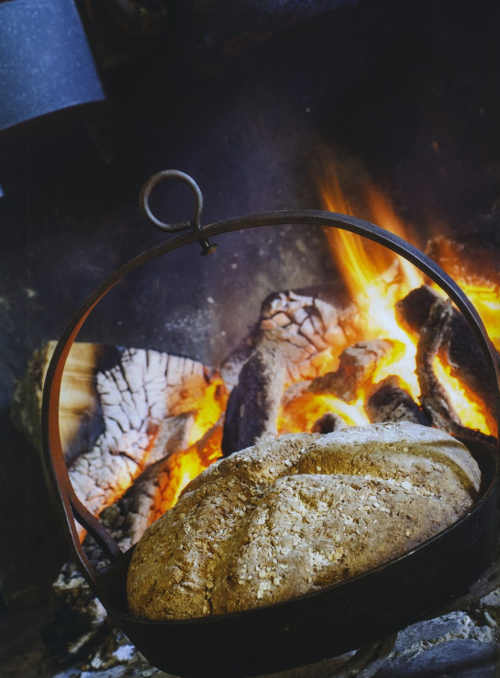 SAMPLE RECIPE: Oaten Bread
SAMPLE RECIPE: Oaten Bread
Oats appear a great deal in Irish cookery and oaten bread was widely eaten on a daily basis. Bread was traditionally baked in a cast-iron pot with lid— a pot oven.
Coals or turf were then placed on top to give radiant heat. Great skill and experience was used in determining the correct coals or turf to be placed on top of the lid to prevent the bread from burning.
Ingredients (Makes 2 medium loaves/1 large)
500g rolled oats
l00g soda bread flour 500ml-1000ml buttermilk
tsp baking powder 2 tsp golden syrup
1 tsp salt
Method
Place oats, baking powder, flour and salt in a bowl.
Add golden syrup and buttermilk gradually.
Mix to a stiff dough.
Turn out onto a lightly floured surface and knead until smooth, then divide in half.
Roll each half into a round, about 6.5 to 7.5cm thick.
Place on lightly greased baking sheet.
Preheat oven to 200C/Gas 6 and bake for 40 minutes until well risen and golden.
Serve warm with lashings of butter.
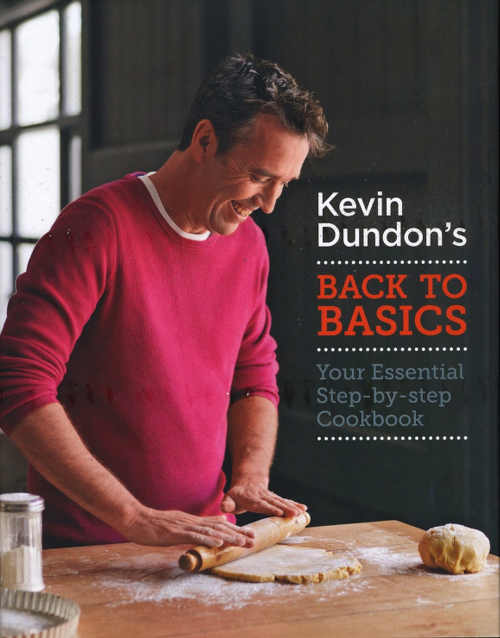 Kevin Dundon’s Back To Basics - Your Essential Step-by-Step Cookbook Mitchell Beazley/Octopus Publishing; hardback 222 pages, photography by Cristian Barnett; £20.
Kevin Dundon’s Back To Basics - Your Essential Step-by-Step Cookbook Mitchell Beazley/Octopus Publishing; hardback 222 pages, photography by Cristian Barnett; £20.
When I first saw this book it reminded me (in a good way) of the old Good Housekeeping Step-by-Step cookery books that my mother had in the1950s. I still have one or two of them and every time I refer to one of their recipes I’m impressed again by the accuracy and attention to detail on every page - a real education, and a vast amount of work in those days before computers and digital imagery.
They may be in black and white, but they sure get the message across and give inexperienced cooks (and perhaps plenty of more experienced ones too) the confidence to learn new techniques and apply them successfully across a range of recipes.
Kevin Dundon’s Back to Basics does the same kind of thing in an appealing modern way, teaching skills rather than just giving recipes - although there is no shortage of those, and this cleverly organised book includes great recipes for all kinds of different occasions.
If you’ve been watching Kevin’s new cookery series ‘Back to Basics’ on UTV Ireland you’ll know the system - each time, he takes a basic ingredient, type of food or technique and, through the recipes, teaches a wide range of skills as you work your way through the series or the book. And it’s all about real food.
The recipes are both down to earth and enticing, covering everything from delicious things to do with eggs (from scrambled eggs to soufflés!), through all kinds of pastries and sauces, to mastering meat, poultry and fish, and of course gorgeous desserts and baking.
Through making all these delicious dishes, that are perfect for showing off to family and friends along the way, you acquire a complete armoury of skills and the confidence to try just about anything.
Common sense tells us that the issues around health and obesity that are worrying us so much today have far more to do with education and life skills than distractions like counting calories.
Kevin’s skills as a chef and cookery school instructor help make this book the pleasurable learning tool that it is, and - although equally appealing to people of all ages and situations - it would be an ideal engagement gift or small wedding present to set a young couple on the path to a lifetime’s enjoyment of good food and better health for themselves and their families.
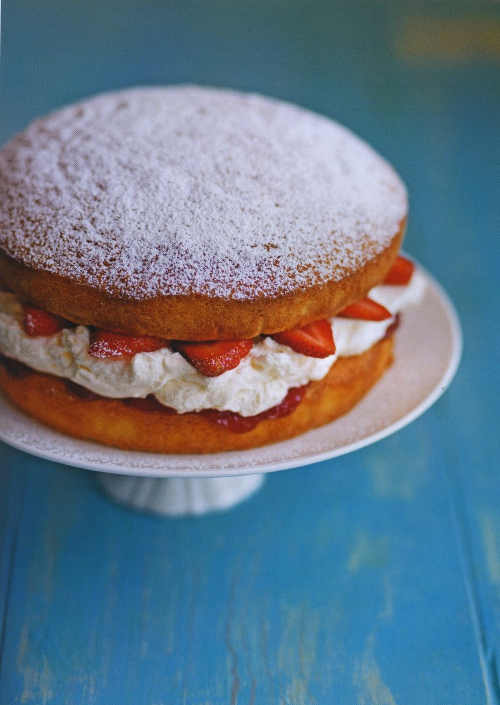 SAMPLE RECIPE: Victoria Sponge with Strawberries
SAMPLE RECIPE: Victoria Sponge with Strawberries
Here we have one of my favourite desserts - great for entertaining. An easy way to remember the proportions in the recipe is to weigh the egg and add the same weight of butter, sugar and flour.
Serves 4-6
300g (2½ sticks plus 1 tbsp) butter, at room temperature, plus extra
for greasing
300g (2½ cups) plain (all-purpose) flour
2 tsp baking powder 300g (21/3 cups) caster (superfine) sugar
5 large (US extra large) eggs
1 tsp vanilla extract
For the filling and topping:
6 tbsp strawberry jam
120ml (½ cup) whipped cream 300g (11oz) strawberries, sliced
Icing (confectioners') sugar, for dusting
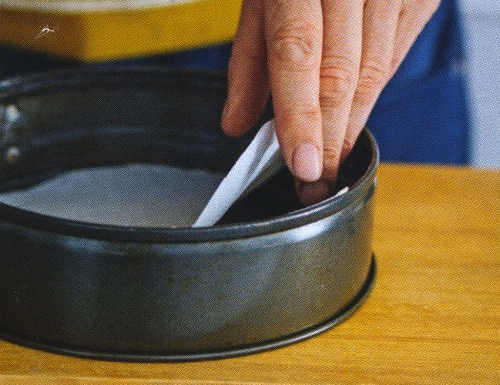 Preheat the oven to 180ºC/350°F/gas mark 4. Grease two 20cm (8 inch) cake tins and line the bottoms with non stick baking (parchment) paper [image (a)].
Preheat the oven to 180ºC/350°F/gas mark 4. Grease two 20cm (8 inch) cake tins and line the bottoms with non stick baking (parchment) paper [image (a)].
Place the flour and baking powder in a bowl and mix together.
In a large separate bowl, beat the butter and sugar until light and fluffy, [image (b)].
Beat in the eggs and vanilla extract, then fold in the flour. Divide the batter evenly between the prepared tins.
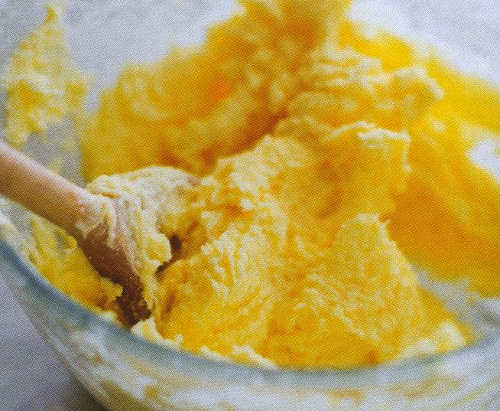 Bake for 25-30 minutes, or until a skewer or toothpick inserted in the centre comes out clean. Turn out the sponges on to a wire rack and leave to cool.
Bake for 25-30 minutes, or until a skewer or toothpick inserted in the centre comes out clean. Turn out the sponges on to a wire rack and leave to cool.
To sandwich the cake together, peel off the lining papers and spread half the jam on each sponge. Cover the jam on one sponge with the whipped cream and sliced strawberries.
Place the second sponge on top, jam-side down. Dust with icing sugar.
Tips and ideas
Use berry compote (recipe given in book) instead of jam.
Try other fillings, such as mascarpone, crème fraiche mixed with strawberry purée or lemon curd.
The filling can be piped on top of your cake if you want to make it even more decorative. Half-fill a piping (pastry) bag fitted with a 1cm (½ inch) star nozzle (tip) and twist closed to make sure it contains no air pockets. You can start by practising on a piece of non stick baking (parchment) paper if you like. Remember that mistakes can be scraped off and you can start again.





There are currently no comments
Leave a comment
Not a member? Register for your free membership now!
Or leave a comment by logging in with: